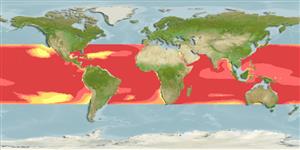>
Tetraodontiformes (Puffers and filefishes) >
Molidae (Molas or Ocean Sunfishes)
Etymology: Masturus: Greek, mastax, -agos = bite + Greek, oura = tail (Ref. 45335).
Environment: milieu / climate zone / depth range / distribution range
Ecologie
marien; brak water bathypelagisch; diepte ? - 670 m (Ref. 36453). Deep-water; 37°N - 35°S
Circumglobal: In tropical to subtropical waters.
Grootte / Gewicht / Leeftijd
Maturity: Lm ? range ? - ? cm
Max length : 337 cm TL mannelijk / geslacht onbekend; (Ref. 6952); max. gepubliceerd gewicht: 2.0 t (Ref. 4424)
Dorsale zachte stralen (totaal) : 15 - 19; Anale zachte stralen: 15 - 19. Dorsal and anal fins similar in shape, positioned far back on body (Ref 53035).
Levenscyclus en paargedrag
Maturiteit | Voortplanting | Paaien | Eieren | Fecunditeit | Larven
Tortonese, E., 1990. Molidae. p. 1077-1079. In J.C. Quero, J.C. Hureau, C. Karrer, A. Post and L. Saldanha (eds.) Check-list of the fishes of the eastern tropical Atlantic (CLOFETA). JNICT, Lisbon; SEI, Paris; and UNESCO, Paris. Vol. 2. (Ref. 6952)
Status op de Rode Lijst van het IUCN (Ref. 130435: Version 2024-1)
Gevaar voor de mens
Harmless
Gebruik door de mens
Tools
Speciale rapporten
Download XML
Internetbronnen
Estimates based on models
Preferred temperature (Ref.
123201): 8.9 - 17.6, mean 12.1 °C (based on 390 cells).
Fylogenetische diversiteitsindex (Ref.
82804): PD
50 = 1.0312 [Uniqueness, from 0.5 = low to 2.0 = high].
Bayesian length-weight: a=0.02455 (0.01023 - 0.05892), b=3.01 (2.80 - 3.22), in cm total length, based on LWR estimates for this (Sub)family-body shape (Ref.
93245).
Trofisch niveau (Ref.
69278): 3.8 ±0.6 se; based on diet studies.
Fishing Vulnerability (Ref.
59153): Very high vulnerability (90 of 100).
